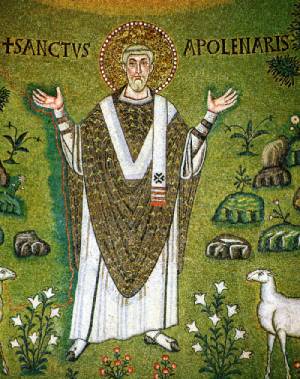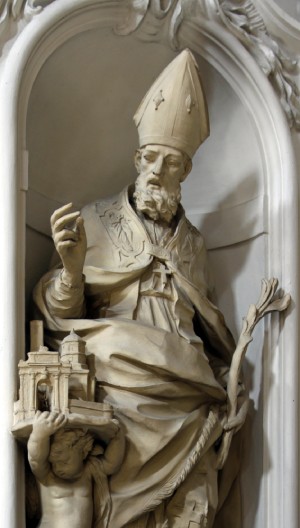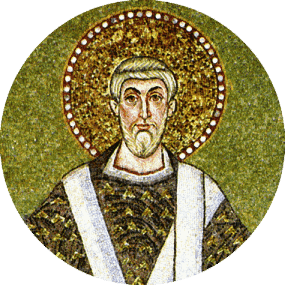20 July
St Apollinaris
Bishop and martyr
Born Antioch, Syria (now Antakya, modern-day Turkey)
Died Ravenna, Italy
Venerated in Roman Catholic Church, Eastern Orthodox Church
Feast July 20 (Roman Catholic Church)
July 23 (pre-1969 General Roman Calendars, Eastern Orthodox Church)
Attributes Sword
Patronage epilepsy; gout; Emilia-Romagna region (Italy) Aachen, Burtscheid, Düsseldorf, Ravenna, Remagen
Early accounts report that Saint Apollinaris was ordained Bishop by Saint Peter himself and sent as a missionary bishop to Ravenna during the reign of the emperor Claudius. Renowned for his powers to heal in the name of Christ, he was frequently exiled, tortured and imprisoned for the faith, and finally martyred.
COLLECT PRAYER
Direct your faithful, Lord, in the way of eternal salvation, which the Bishop Saint Apollinaris showed by his teaching and martyrdom, and grant, through, his intercession, that we may so persevere in keeping your commandments as to merit being crowned with him. Through our Lord Jesus Christ, your Son, who lives and reigns with you in the unity of the Holy Spirit, God, for ever and ever.

Things to Do:
- The Basilica of St. Apollinaris is considered the cradle of the Christian Faith in Italy and preserves the body of St. Apollinaris. Read the Pope John Paul II’s message on the 1,450th anniversary of the dedication of the Basilica
- View some of the beautiful mosaics in the Basilicas of St. Apollinaris and St. Vitalis (German site – click on the main graphic, you don’t have to speak German to enjoy the beautiful pictures!) and also this site on Ravenna Mosaics which includes some history
- This link gives a little information about Byzantine Italy. More maps
- This link will give you the historical background on how Ravenna, Italy ended up with the glories of Byzantium in its Basilicas
- Read what the Catholic Encyclopedia says about Ravenna
- Go here for additional information
St. Apollinaris

Apollinaris came to Rome from Antioch with the prince of the apostles, by whom he was consecrated bishop, and sent to Ravenna to preach the Gospel of our Lord Jesus Christ. He converted many to the faith of Christ, for which reason he was seized by the priests of the idols and severely beaten.
At his prayer, a nobleman named Boniface, who had long been dumb, recovered the power of speech, and his daughter was delivered from an unclean spirit; on this account a fresh sedition was raised against Apollinaris.
He was beaten with rods, and made to walk barefoot over burning coals; but as the fire did him no injury, he was driven from the city.
He lay hidden sometime in the house of certain Christians, and then went to Aemilia.
Here he raised from the dead the daughter of Rufinus, a patrician, whose whole family thereupon believed in Jesus Christ.
The prefect was greatly angered by this conversion, and sending for Apollinaris he sternly commanded him to give over propagating the faith of Christ in the city.
But as Apollinaris paid no attention to his commands, he was tortured on the rack, boiling water was poured upon his wounds, and his mouth was bruised and broken with a stone; finally, he was loaded with irons, and shut up in prison. Four days afterward he was put on board ship and sent into exile; but the boat was wrecked, and Apollinaris arrived in Mysia, whence he passed to the banks of the Danube and into Thrace.
In the temple of Serapis the demon refused to utter his oracles so long as the disciple of the apostle Peter remained there. A search was made for some time, and then Apollinaris was discovered and commanded to depart by sea. Thus he returned to Ravenna; but on the accusation of the same priests of the idols, he was placed in the custody of a centurion.
As this man, however, worshipped Christ in secret, Apollinaris was allowed to escape by night. When this became known, he was pursued and overtaken by the guards, who loaded him with blows and left him, as they thought, dead.
He was carried away by the Christians, and seven days after, while exhorting them to constancy in the faith, he passed away from this life, to be crowned with the glory of martyrdom. His body was buried near the city walls.
— Excerpted from Roman Martyrology
Source: CATHOLIC CULTURE
